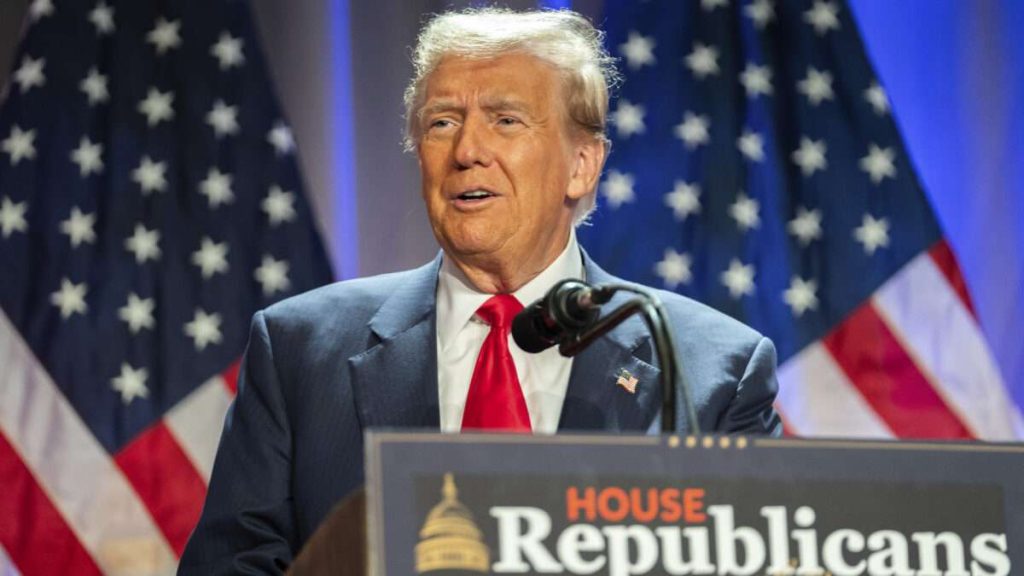
The name of President-elect Donald Trump’s so-called Department of Government Efficiency (DOGE) is tellingly ambiguous. Despite the “department” label, Trump says DOGE, which will be overseen by billionaire entrepreneur Elon Musk and former presidential candidate Vivek Ramaswamy, will “provide advice and guidance from outside of government.” That makes DOGE sound more like an advisory committee than an actual federal agency (which would require congressional authorization). And exactly what Trump means by “efficiency,” a potentially broad but possibly narrow concept, remains unclear.
Trump, who has never previously shown much interest in fiscal restraint, promises “drastic change,” resulting in “a smaller Government, with more efficiency and less bureaucracy.” With Musk and Ramaswamy’s help, he said, “we will drive out the massive waste and fraud which exists throughout our annual $6.5 Trillion Dollars of Government Spending.”
Trump’s invocation of “massive waste and fraud” is not new for him or for politicians generally. Presidents and legislators are perenially promising to root out “waste, fraud, and abuse,” implying that such efforts could make a substantial dent in federal spending. Unlike, say, entitlement reform or cuts in military spending, that goal has the advantage of being politically uncontroversial. But the potential payoff, while nothing to sneeze at, is commensurately smaller.
Responding to Musk’s suggestion that DOGE could identify “at least” $2 trillion in federal spending cuts, Manhattan Institute budget expert Brian Riedl told The Washington Post it was “absolutely absurd” to suggest that such savings could be achieved by targeting “wasteful and unnecessary programs.” Alluding to Musk’s business background, Riedl added that “there’s a long history of the fantasy that one smart businessman will just identify trillions in waste, but that’s just not how it works.” Or as the Peter G. Peterson Foundation put it back in 2010, “curbing waste, fraud and abuse sound[s] great but would not produce very significant savings.”
Although “waste, fraud, and abuse” clearly are not the main drivers of runaway federal deficits and debt, the sums involved are not exactly chump change either. Last March, the Government Accountability Office (GAO) said federal agencies “reported an estimated $236 billion” in “improper payments”—defined as “payments that should not have been made or were made in an incorrect amount”—during fiscal year 2023. Medicare, Medicaid, and “federal pandemic unemployment assistance” each accounted for about a fifth of those improper payments. Two other significant contributors were the Earned Income Tax Credit (9 percent) and the pandemic-inspired Paycheck Protection Program (8 percent); “all other programs” accounted for 21 percent.
In April, the GAO estimated that “the federal government could lose between $233 billion and $521 billion annually to fraud.” The programs posing the highest fraud risks, according to a subsequent GAO report, are Medicare, Medicaid, unemployment insurance, the Paycheck Protection Program, the Earned Income Tax Credit, and Supplemental Security Income.
If we assume that something like $500 billion a year could be saved by attacking fraud and other improper payments, that would amount to around 7 percent of the federal budget (which totaled $6.8 trillion in fiscal year 2024) and 28 percent of the annual deficit ($1.8 trillion that year, according to the latest estimate from the Congressional Budget Office). But that assumption is overly optimistic for several reasons.
First, $521 billion was the GAO’s high-end estimate of fraud. Second, completely eliminating fraud is an unrealistic goal. Third (and relatedly), preventing fraud costs money: The Congressional Budget Office, for example, assumes that each dollar spent on measures to prevent health care fraud generates $1.50 in savings.
Aside from those considerations, politicians tend to exaggerate the extent of preventable fraud. During a 2016 presidential debate, for example, Trump said he would “save Social Security” by attacking the “tremendous waste, fraud and abuse” within the program. “We have in Social Security right now thousands and thousands of people that are over 106 years old,” he averred. “Now, you know they don’t exist.”
The Committee for a Responsible Federal Budget (CRFB) noted that “ending benefit payments to thousands of beneficiaries would barely move the needle on solvency,” adding that “there would need to be almost 10 million ineligible 106-year olds in order to save Social Security solely by ending fraudulent and mistaken payments.” In any case, according to a 2013 report from the Social Security Administration’s inspector general, “there were just over 1,500 deceased individuals still receiving benefits in total, including many below the age of 106 and accounting for about $15 million in additional improper benefit payments.” A 2015 report “did find 6.5 million active Social Security numbers for people over the age of 112—but only 13 of them were being used to receive benefits.”
Those numbers, the CRFB said, suggested that the problem described by Trump involved “between 13 and 1,500 recipients,” which would cost “between $200,000 and $15 million annually.” Stopping all of those payments therefore “would reduce program costs by between 0.00002 and 0.002 percent.”
In contrast with fraud, which entails deliberate deception, “waste” (like “efficiency”) can be defined in various ways. Consider health care spending.
According to a 2019 study, the Peter G. Peterson Foundation noted last year, “the annual cost of wasteful spending in healthcare has ranged from $760 billion to $935 billion in recent years, or nearly one-quarter of total healthcare spending.” Since “34 percent of the nation’s healthcare spending is funded by the federal government,” this category of waste potentially could amount to a few hundred billion dollars in federal spending each year.
“Such spending can generally be categorized as administrative waste, inefficient spending on clinical care, or operational waste,” the foundation explained. The first category includes “administrative complexity” as well as “fraud and abuse.” The second category includes “failures of care delivery,” “low-value care,” and “failures of care coordination.” The third category includes “inconsistent pricing” and “misuse of medical materials.”
These problems are tough to tackle, especially given the dominance of third-party payments by private insurers or government programs, which obscures price signals to consumers. But theoretically, there are significant potential savings.
The $6.2 trillion that Congress approved for pandemic relief further illustrates the possible meanings of “waste, fraud, and abuse.” Last year, the House Committee on Oversight and Accountability described “federal pandemic spending” as “a prescription for waste, fraud, and abuse,” which is apt because the government prioritized getting money out the door over ensuring the money was well spent. “When the federal government provides emergency assistance,” the GAO noted last year, “the risk of payment errors—including those attributable to fraud—may increase because the need to provide this assistance quickly can lead agencies to relax or forego effective safeguards.”
Testifying before the House oversight committee, Michael Horowitz, the Justice Department’s inspector general, noted that “over 69,000 questionable Social Security Numbers” had been used to “obtain $5.4 billion in pandemic loans and grants.” That was just one example of suspected fraud, which also included people who misrepresented their financial circumstances, invented businesses, or otherwise obtained money to which they were not legally entitled.
As Reason‘s Eric Boehm reported last year, “auditors believe that about $200 billion was fraudulently disbursed from two programs run by the Small Business Administration (SBA) during the pandemic,” which amounted to “about one-sixth of all spending run through the SBA’s Paycheck Protection Program (PPP) and the Economic Injury Disaster Loan (EIDL) program.” In addition, “the GAO believes that between $100 billion and $135 billion in federal unemployment funds—provided to states on a temporary basis during the pandemic—were lost to fraud. One former U.S. attorney has called it ‘the biggest fraud in a generation.'” Exactly how big is unclear, Boehm noted: “Auditors now say we’ll likely never have a full accounting of it all.”
Beyond outright fraud, Horowitz cited evidence suggesting that much of the relief money was wasted. When the Pandemic Response Accountability Committee examined “51,000 grants worth $347 billion, spread across 250 programs,” he said, “we found numerous challenges and problems.” They included 15,000 grants with “meaningless descriptions that made it difficult to know what that money was used for”; more than 12,000 grants with opaque descriptions that repeated the name of the program”; and “another 2,500 awards” that “used indecipherable technical jargon.”
Depending on how you interpret “waste,” the category could encompass broad swaths of pandemic relief spending, such as the “economic impact payments,” totaling $814 billion, that the government repeatedly sent to “eligible individuals.” Contrary to the way those payments were portrayed, eligibility did not require any evidence that the recipients had actually suffered any economic harm as a result of the pandemic. As Congress saw it, that was neither “fraud” nor “waste,” since the scheme worked as designed. But it was certainly a political fraud and a misuse of resources. Although it was “efficient” at delivering 476 million checks, it did so without rhyme or reason.
Federal aid to state governments during the pandemic was wasteful in a similar sense. States often fared better financially than expected and had trouble spending the money they supposedly needed.
The experience with pandemic spending illustrates both the perils and the potential of framing DOGE’s mission as conquering “waste” or promoting “efficiency.” Narrowly understood, those goals could mean little more than making sure that programs operate as intended. Broadly understood, minimizing waste and maximizing efficiency would include asking whether the programs should exist in the first place.
Ramaswamy, for instance, wants to abolish the Department of Education, which critics view as constitutionally unauthorized, wasteful, and intrusive. If Ramaswamy imagines that the department’s functions would be reassigned to other federal agencies, the proposal would amount to nothing but a bureaucratic shuffle. But if he is saying federal education programs should be eliminated along with the department, that would be a meaningful change, although cutting $238 billion in spending would be a modest step toward fiscal responsibility, accounting for less than 4 percent of the federal budget.
More likely, DOGE will devolve into a hunt for “waste, fraud, and abuse” as those concepts are conventionally understood. While that does not mean its efforts will have no real impact, it does mean we should temper our expectations. When it comes to shrinking the increasingly alarming gap between federal revenue and federal spending, there is no shortage of potentially viable plans. But all of them entail tradeoffs and political risks. There is no such thing as an easy win.
The post The Impact of Trump’s Cost-Cutting Initiative Hinges on What He Means by ‘Government Efficiency’ appeared first on Reason.com.







